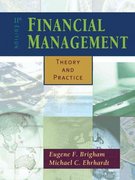Question
1. Interest compounding: Select one: a. calculates the present when the future is known b. calculates interest periodically c. results in less interest than simple
1. Interest compounding:
Select one:
a. calculates the present when the future is known
b. calculates interest periodically
c. results in less interest than simple interest
d. is done only once a year
2. Present value is best defined as:
Select one:
a. the amount that must be invested per year and compounded at a specified rate and time to reach a specified present value
b. the amount of a specified future value compounded at a specified rate which can be invested currently
c. all of these are appropriate definitions for present value
d. the amount that must be invested now and compounded at a specified rate and time to reach a specified future value
3. The effective rate is:
Select one:
a. the stated rate
b. the simple rate
c. the true annual rate
d. the true semiannual rate
4. Present value does not:
Select one:
a. find the present dollar amount
b. know the present dollar amount
c. know the future value
d. use the tables
5. When compounding interest, a common mistake is to add the interest to the:
Select one:
a. present value
b. previous principal
c. original principal
d. future value
6. When interest is added to the principal amount and then interest is calculated on this new amount, the process is called:
Select one:
a. compound interest
b. single interest
c. simple interest
d. present value
7. The term "compounding semiannually" means:
Select one:
a. compounding twelve times a year
b. compounding four times a year
c. compounding twice a year
d. none of these
8. When comparing the same period of time and interest rate used to compute simple interest, compound interest results in:
Select one:
a. increased yield for the investor
b. higher interest charges to the investor
c. all of these occur using compound interest
d. an increased maturity date
9. Angelo wants to make an investment today so that he can have $2700 in a year to buy some new kitchen appliances. How much should he set aside now if he can invest the money at 1.6% annually, compounded annually?
Select one:
a. $2327.59
b. $2647.48
c. $1687.50
d. $2657.48
10. Unlike simple interest, compound interest is never found using a:
Select one:
a. formula
b. 365-day year
c. manual compounding
d. 360-day year
11. Provide an appropriate response. The accumulation phase of an annuity is characterized by: I. paying money into the fund II. receiving money from the fund III. the fund balance may earn compound interest
Select one:
a. III only
b. II only
c. I only
d. both I and III
Step by Step Solution
There are 3 Steps involved in it
Step: 1

Get Instant Access to Expert-Tailored Solutions
See step-by-step solutions with expert insights and AI powered tools for academic success
Step: 2

Step: 3

Ace Your Homework with AI
Get the answers you need in no time with our AI-driven, step-by-step assistance
Get Started


